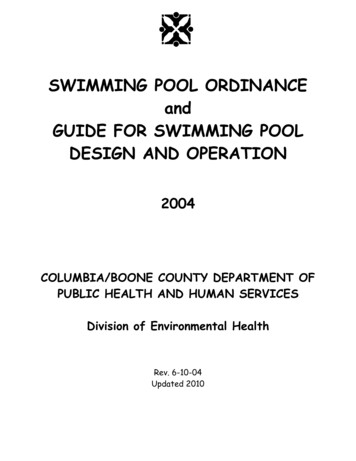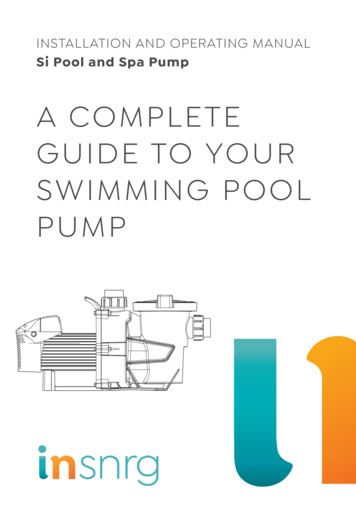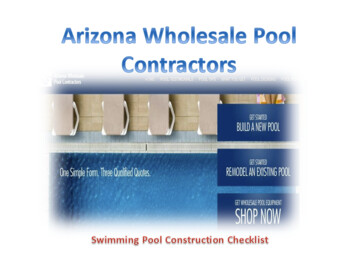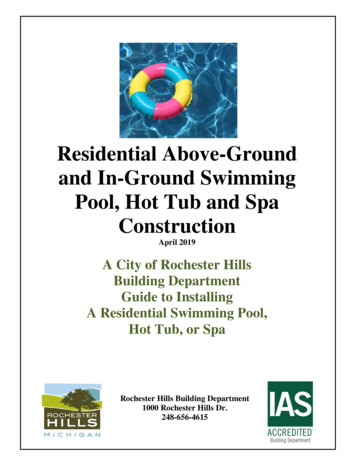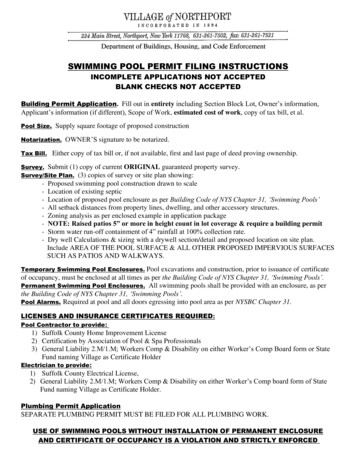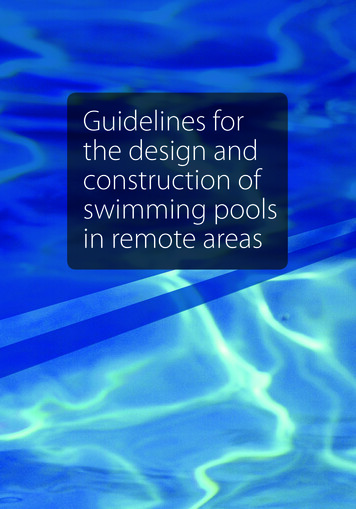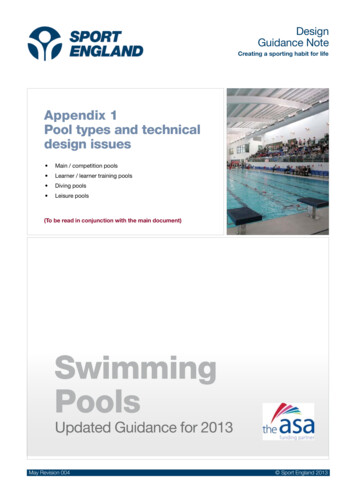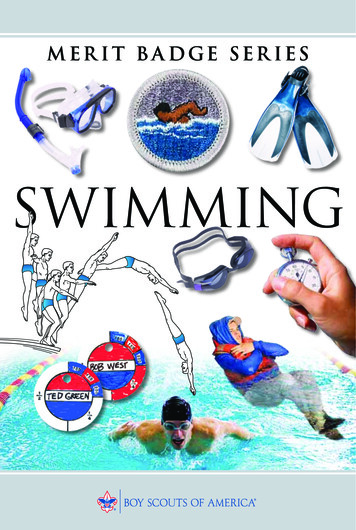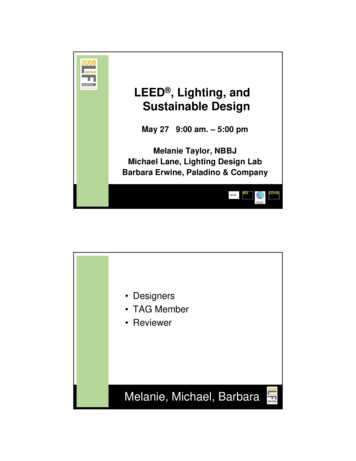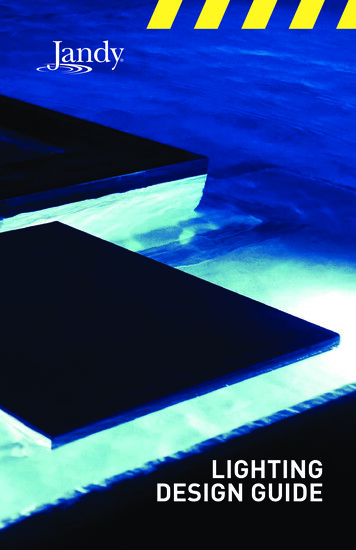
Transcription
LIGHTINGDESIGN GUIDE
2
05 THERE WAS A TIME 08 LIGHTING PHILOSOPHY10 GENERAL LIGHTING PRINCIPLES20 LIGHTING DIFFERENT POOL SHAPES31 LIGHTING POOL FEATURES45 LIGHTING FLOWING WATER53 PRINCIPLES IN PRACTICE3
4
THERE WASA TIME WHEN SWIMMING POOLS WERE SIMPLE.They came as rectangles or in kidney shapes and, ifthey had lighting, they were equipped with a single500-watt incandescent bulb set in one end or the other.Those days are gone. Today’s pools come with tanningshelves, swim lanes, stepping stones, vanishing edges,water features and more, making lighting design amore complicated task than was the case a generationago. Today's LED lights are more advanced and smallenough to fit into spaces that weren’t possible before.5
WHEN IT COMES TO LIGHT PLACEMENT— YOU SHOULDN'T HAVE TO GUESS.This guide is intended to assist designers andbuilders with basic and advanced lighting conceptsto illuminate even the most complex pools.For the purposes of this guide, we’ll focus on lightingtechniques using nicheless LED lights, since they providethe most flexibility — but demand the most thoughtand care — through the lighting design process.6
While this guide should help you light any pool onyour own, feel free to reach out to us with furtherquestions at lighting.design@zodiac.com.7
SSAFEETY&A&AESTTHET8
EATTLIGHTINGPHILOSOPHYSAFETY FIRSTFirst and foremost, lighting helps preventaccidents. As internal and external configurationsof swimming pools become more complex —creating blind spots and shadows — the need toaddress proper lighting has risen exponentially.Ensure all safety areas, such as pool steps,entrances and exits, are properly illuminated.MOOD AND AMBIENCESubtleties in lighting can drastically alter the moodof a backyard landscape, contributing to the owner'senjoyment and satisfaction with the design.While safety is the number one concern,the ability to alter and manage mood andambiance to suit the homeowner’s needsshould also be paramount in the mind of thedesigner as light placement is determined.9
10
GENERALLIGHTINGPRINCIPLESCALCULATING HOW MANYLIGHTS YOU NEEDWhen designing a pool with nicheless lights, thegeneral rule is to divide the length of the pool by 8feet and round to the nearest whole number.PRO TIPDarker finishes requiremore light, so weoften advise roundingup after dividing thelength by 8 feet.For example:The pool is 30 feet long. Since 30 8 3.75, place4 lights in the pool spaced evenly apart.On plain rectangular pools this rule is the standard,but freeform designs or pools with other featuresmay need additional lights and will be addressedlater in this guide.LIGHTING GOALSThe goal in organizing a lighting scheme is toeliminate dark spots, avoid hot spots, and createa beautiful, even glow throughout the pool.Generally, it is better to install a greater numberof lower wattage lights than a fewer number ofhigher wattage lights. Although total wattagewill be similar, adding more lights helpscreate that desired, even glow throughout.Factors inDeciding LightingPlacement andQuantity Position ofthe residencein relation tothe pool Size & shapeof the pool Color of thepool finish Features Intended use11
ORIENTATIONAlways position lights so the beam is directed awayfrom the residence and its primary viewpoints. Thegoal is to hide the source of light, giving the illusionthat the pool glows on its own.16'32'Parallel to HouseIf the pool is parallel to the homePlace lights on the wall closest to the houseso that the homeowner and guests are notlooking directly into the beams of light.16'32'Perpendicular to HouseIf the pool is perpendicular to the housePlace lights facing away from the side of the yardthat will be used most (i.e., patios, lawns, etc.).12PRO TIPWe assist buildersand designers withthousands of no-costdrawing/plan reviewsevery year. We neverrecommend fewer thanone light per 8'. No onehas ever complainedthat there is too muchlight in the pool.
PLACEMENTIn square or rectangular poolsSpace lights about every 8 feet along the wall tocreate an even glow.60 60 60 60 60 PRO TIPSupplementallighting is calledfor where intricateconfigurations andsurfaces are involved.For example: if there’sa feature that meritsdetailed attention likean interior mosaic,rockwork that reachesbelow the waterline,or lights that need tobe placed on steps.Pools with CurvesPools with curves and turnsMap out angles assuming a 60-degreebeam spread. The actual beam spread willbe wider, but the light within the 60-degreearc will provide optimal intensity and evenlight distribution throughout the pool.Main pool bodyPlace lights at a uniform depth, between9-12 inches below the waterline, throughoutthe pool. Possible exceptions would be if thelights need to be placed on a step or benchor extremely deep pools (see Pro Tip).Tanning shelvesLights should be positioned 4 inchesbeneath the waterline.SpasPlace lights below the bench or in the footwell.Doing so keeps people from resting their backsagainst a warm light and blocking out the light.BenchesIf a bench runs along the side of the pool where thelights need to be placed, install lights several inchesbelow the edge of the bench to prevent shadows.PRO TIPFor deep ends greaterthan 12 feet placelights between 18–24inches below the waterline. In the shallowend keep lights within9–12 inches of thesurface of the water13
SURFACESThe pool finish can dramatically affect how the lights perform relative toyour design goals, since lighter finishes reflect light, while darker finishesabsorb light. The following chart provides a guideline for determining whatwattage size to use:WATTAGE SELECTOR GUIDEPOOL FINISHILLUMINATION DISTANCEColor LightsLightMediumUp to 12 ft12 – 20 ft20 ft Up to 10 ft10 – 16 ft16 ft Up to 8 ftDark8 – 12 ft12 ft Visit Jandy.com for part numbers and full list of available models.NUTS AND BOLTS — SYSTEMDESIGN CONSIDERATIONSKnowing the basic principles of how to optimizethe performance of LED lighting makes all of thedifference in pool illumination. Placeall lights on the same on/off circuit. Alwaysupsize the transformer with at least a20% buffer to make certain it has the capacity tohandle surges. For example: if you’re installingfour 24-watt LED lights, use a 300-watttransformer unit instead of a 100-watt unit.14
It is not recommended to use color lights in dark finish pools. Certain colors willbe absorbed and not perform as well resulting in a dimly lit pool. White lightsdeliver about twice the brightness (by wattage) and make your pool shine.RECOMMENDED POWERWhite Lights(Watts)Up to 16 ft16 – 24 ft24 ft Up to 14 ft14 – 22 ft22 ft 6122461224Up to 12 ft612 – 20 ft20 ft 1224 Alwaystest lights at the appropriate voltage toavoid damage to low-voltage LEDs — a jolt of 120Vline-voltage current — even for a split second — willpermanently damage or destroy low-voltage LEDs. Ensurethe transformer and control system havebeen certified as safe for the intended application bya Nationally Recognized Testing Laboratory (NRTL).PRO TIPIf you are havingdifficulty pulling acord through theconduit, lubricate thecord with dish soap orwire pulling lubricant.Do not use petroleumbased lubricants. Beconsistent using only one brand and type oflights throughout the pool to avoid syncing or colormatching issues, or other unintended results.15
Removing the halo effectIn pools with a lighter finish, a halo effect mayresult from light reflecting off the water’s surface.To eliminate the halo effect without sacrificingillumination, use a Lens Cover. Lens covers areeasily attached, and can also be used to redirectlight away from the eyes on stairs, baja shelves, laplanes, etc.Lens covers come in ¼-moon and ½-moon sizes.Since trial and error may be needed to determinewhich size works best in each scenario, four of eachlens cover type come in the lens cover kit. An extrainstallation tool will also be included. The kits areavailable in gray, black, or white colors.Quarter MoonHalf MoonLens cover kit part numbers:Gray (LENSCVRG), Black (LENSCVRB), White (LENSCVRW)16
LIGHTS ONLYWITH LENS COVERS17
COOL BY DESIGNJandy WaterColors Nicheless LED Lights with TechnologyEngineeredwithHydroCooltechnologyto providelong-lastingperformanceJandy HydroCool lights use an innovative, energy-efficient designthat harnesses the cooling power of water to create a coolerrunning, longer lasting* light. Designed to fit in a standard 1 ½"return fitting, these lights are shorter to accommodate complex pooldesigns, and operate at lower wattages (6w, 12w, and 24w), whileproviding the same brilliant illumination as previous models.*Based on internal testing.
BUILT TO LASTA MORE EVEN GLOWTriple-material, unibodyconstruction design preventsleaks and maximizesdurability under water.The diffuser lens providesbetter blending of colorsfor the clearest and mostconsistent lighting in its class.MADE TO MATCHLights come standard in black with complimentary gray and white cosmetictrim ring covers to match a larger variety of pool surfaces.HYDROCOOL LIGHTUp to 8" shorterthan our previousmodels for morecreative designflexibilityPREVIOUS MODELDaylight WhiteCOMPATIBILITYColor optionsfor use with allmajor automationsystemsWarm WhiteS-SeriesH-SeriesP-SeriesJandy WaterColors
LIGHTINGDIFFERENTPOOL SHAPES20
RECTANGULAR POOLSUltimately, while all lighting options must meetrequired safety standards, lighting a pool comesdown to a balance of desired ambiance and cost.THREE OPTIONS:Option 1More lights at lower wattagesThis is the ideal lighting solution and results in amore even glow with fewer hot spots or dark spaces.Space lights out at approximately 8 footintervals along a straight wall.16'32'16'32'PARALLELPERPENDICULARPRO TIPWhen quoting a pooldesign to a prospectivecustomer it is alwaysbest to quote the poolwith the ideal lightingscenario first (morelights for a more evenglow). This will give youthe flexibility to removelights from the quote ifprice becomes an issue,thereby allowing thecustomer to make thechoice between priceand optimal lighting.PRO TIPFor pools that areperpendicular to thehouse and symmetryis a high priority thereare 2 options: 1) staggerlights at 8 foot intervalson either side of thepool, or 2) double thenumber of lights andplace them oppositeeach other along thelength of the pool. Ifthe latter option ischosen use the wattageguide to determine thecorrect power to reachhalfway across the pool.21
RECTANGULAR POOLSCONTINUEDOption 2Fewer lights at higher wattagesSpaced evenly apart, this lighting strategy canlower the cost to the client while still providingsufficient light into the pool and keeping all lightsfacing away from the residence. Since the higherwattage affects the distance, or throw of the light,and not the spread angle, the result is still not asnice as using a fourth light (as shown in option 1).16'32'22
Option 3The bare minimumUsing fewer lights with the highestwattage may provide for safe illumination,but is aesthetically undesirable.16'32'23
KIDNEY-SHAPED ORFREEFORM POOLSOption 1More lights at lower wattagesOne light for roughly every 8 feet of pool isthe ideal option and allows for even lightdistribution and ensures an even glowwithout hot spots or dark spaces.24'18'24
6 0'6 0'60'60'60'PRO TIPWhile HydroCool lightshave a true beamspread of nearly 180degrees, the mostconcentrated portion ofthe beam on nichelesslights spans an angle of60 degrees. Designersshould ensure thatthe opposite wall ofkidney or free-formshaped pools areevenly covered by the60-degree beam spread.PRO TIPFor "L" shaped poolsconsider the differentsections as twoseparate bodies ofwater and then lightthem accordingly.25
KIDNEY-SHAPED ORFREEFORM POOLSCONTINUEDOption 2Fewer lights at higher wattagesand different anglesThis lighting solution lowers the cost to the client,while still safely lighting the pool. This option worksbetter for a pool with a light color finish. In a darkcolored pool, the light is likely to be absorbed beforeit has a chance to extend across the whole pool.24'18'26PRO TIPUsing fewer LEDsat greater wattagesrequires placementat different angles toeffectively and safelylight the entire pool.
GEOMETRIC POOLSDue to the highly angular configuration ofgeometric pools and an infinite number ofvariations in shape and size, determininglighting placement is more complex.In these instances, nicheless lights really shine.Keep beam spread in mind when it comes topotential shadows and dark spots to ensure allparts of the pool are safely and adequately lit.27
LAP POOLS OR SWIM LANESTraditional lap poolSpace lights out evenly at 8–10 foot intervals alongthe lap lane section of the pool — parallel to thelap lane (as shown below). Never point lightsdown a lap lane into the eyes of the swimmer.70'22'28PRO TIPTo avoid creating a hotspot, it will often benecessary to adjustwattages according tothe distance neededto be covered in selectsections of the pool.
FREE-FORM POOLSWITH LAP LANESAlways treat a 40-foot or longer section of a freeform pool like a lap lane. Make sure to place thelights so they don't point down the “lane” into theeyes of the swimmer.'2850'PRO TIPEven if the customerclaims they won’t usea 40 foot sectionof the pool as a laplane, a guest or afuture owner ofthe home may.29
SPASAlways place lights below the bench and never inthe seat wall where someone might rest their back.As in a pool, it’s best to point lights away from theresidence, however, due to the deeper placementof the lights this tends not to be as crucial a factor.In a typical four-to-six-person spa with a lightfinish, one 6W light is sufficient, but for largerspas, or those with a dark finish, a 12W lightor an additional light is recommended.30
LIGHTINGPOOLFEATURES31
SHALLOW LOUNGING AREASOtherwise known as sun shelves, baja shelvesor wet decks, these shallow features haveincreased in popularity in recent years.To light the wet deck properly, lights sho
WHEN SWIMMING POOLS WERE SIMPLE. They came as rectangles or in kidney shapes and, if they had lighting, they were equipped with a single 500-watt incandescent bulb set in one end or the other. Those days are gone. Today’s pools come with tanning shelves, swim lanes, stepping stones, vanishing edges, water features and more, making lighting design a more complicated task than was the case
